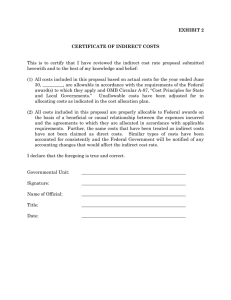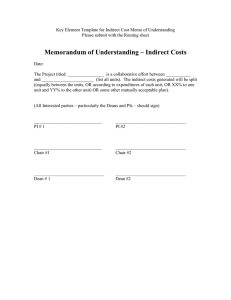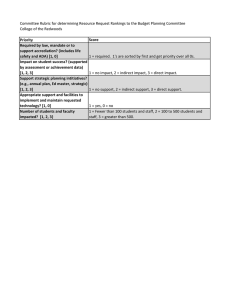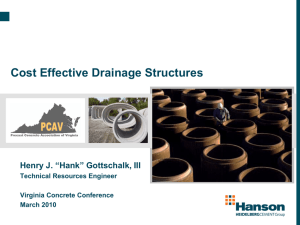chapter 8
advertisement
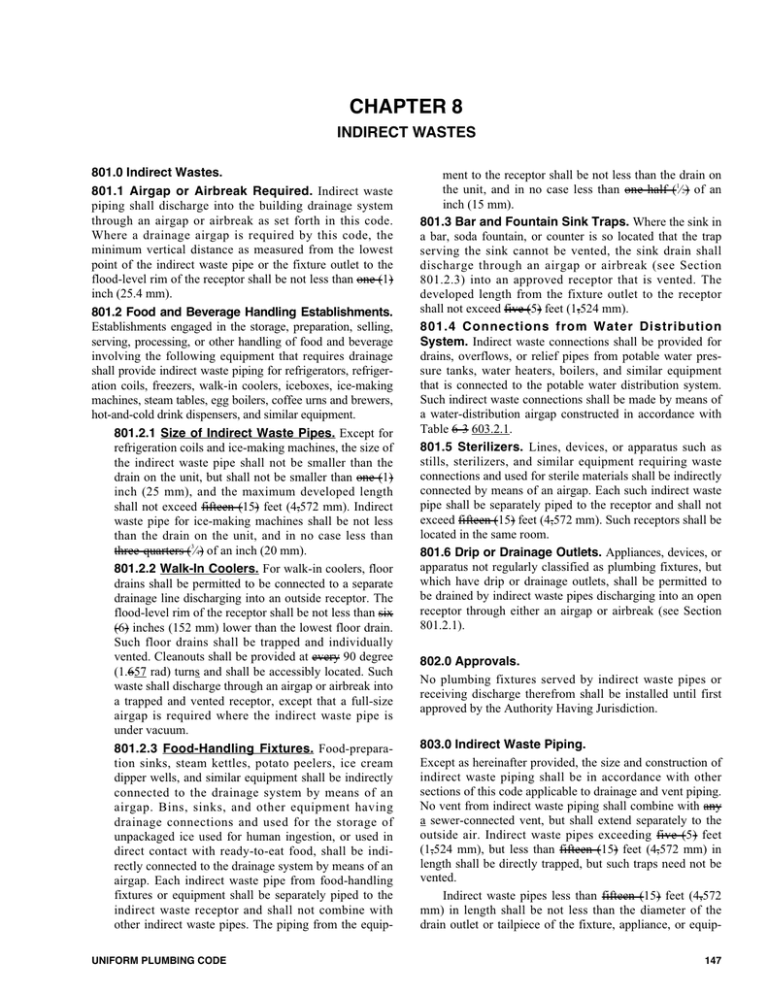
CHAPTER 8 INDIRECT WASTES 801.0 Indirect Wastes. 801.1 Airgap or Airbreak Required. Indirect waste piping shall discharge into the building drainage system through an airgap or airbreak as set forth in this code. Where a drainage airgap is required by this code, the minimum vertical distance as measured from the lowest point of the indirect waste pipe or the fixture outlet to the flood-level rim of the receptor shall be not less than one (1) inch (25.4 mm). 801.2 Food and Beverage Handling Establishments. Establishments engaged in the storage, preparation, selling, serving, processing, or other handling of food and beverage involving the following equipment that requires drainage shall provide indirect waste piping for refrigerators, refrigeration coils, freezers, walk-in coolers, iceboxes, ice-making machines, steam tables, egg boilers, coffee urns and brewers, hot-and-cold drink dispensers, and similar equipment. 801.2.1 Size of Indirect Waste Pipes. Except for refrigeration coils and ice-making machines, the size of the indirect waste pipe shall not be smaller than the drain on the unit, but shall not be smaller than one (1) inch (25 mm), and the maximum developed length shall not exceed fifteen (15) feet (4,572 mm). Indirect waste pipe for ice-making machines shall be not less than the drain on the unit, and in no case less than three-quarters (3⁄4) of an inch (20 mm). 801.2.2 Walk-In Coolers. For walk-in coolers, floor drains shall be permitted to be connected to a separate drainage line discharging into an outside receptor. The flood-level rim of the receptor shall be not less than six (6) inches (152 mm) lower than the lowest floor drain. Such floor drains shall be trapped and individually vented. Cleanouts shall be provided at every 90 degree (1.657 rad) turns and shall be accessibly located. Such waste shall discharge through an airgap or airbreak into a trapped and vented receptor, except that a full-size airgap is required where the indirect waste pipe is under vacuum. 801.2.3 Food-Handling Fixtures. Food-preparation sinks, steam kettles, potato peelers, ice cream dipper wells, and similar equipment shall be indirectly connected to the drainage system by means of an airgap. Bins, sinks, and other equipment having drainage connections and used for the storage of unpackaged ice used for human ingestion, or used in direct contact with ready-to-eat food, shall be indirectly connected to the drainage system by means of an airgap. Each indirect waste pipe from food-handling fixtures or equipment shall be separately piped to the indirect waste receptor and shall not combine with other indirect waste pipes. The piping from the equipUNIFORM PLUMBING CODE ment to the receptor shall be not less than the drain on the unit, and in no case less than one-half (1⁄2) of an inch (15 mm). 801.3 Bar and Fountain Sink Traps. Where the sink in a bar, soda fountain, or counter is so located that the trap serving the sink cannot be vented, the sink drain shall discharge through an airgap or airbreak (see Section 801.2.3) into an approved receptor that is vented. The developed length from the fixture outlet to the receptor shall not exceed five (5) feet (1,524 mm). 801.4 Connections from Water Distribution System. Indirect waste connections shall be provided for drains, overflows, or relief pipes from potable water pressure tanks, water heaters, boilers, and similar equipment that is connected to the potable water distribution system. Such indirect waste connections shall be made by means of a water-distribution airgap constructed in accordance with Table 6-3 603.2.1. 801.5 Sterilizers. Lines, devices, or apparatus such as stills, sterilizers, and similar equipment requiring waste connections and used for sterile materials shall be indirectly connected by means of an airgap. Each such indirect waste pipe shall be separately piped to the receptor and shall not exceed fifteen (15) feet (4,572 mm). Such receptors shall be located in the same room. 801.6 Drip or Drainage Outlets. Appliances, devices, or apparatus not regularly classified as plumbing fixtures, but which have drip or drainage outlets, shall be permitted to be drained by indirect waste pipes discharging into an open receptor through either an airgap or airbreak (see Section 801.2.1). 802.0 Approvals. No plumbing fixtures served by indirect waste pipes or receiving discharge therefrom shall be installed until first approved by the Authority Having Jurisdiction. 803.0 Indirect Waste Piping. Except as hereinafter provided, the size and construction of indirect waste piping shall be in accordance with other sections of this code applicable to drainage and vent piping. No vent from indirect waste piping shall combine with any a sewer-connected vent, but shall extend separately to the outside air. Indirect waste pipes exceeding five (5) feet (1,524 mm), but less than fifteen (15) feet (4,572 mm) in length shall be directly trapped, but such traps need not be vented. Indirect waste pipes less than fifteen (15) feet (4,572 mm) in length shall be not less than the diameter of the drain outlet or tailpiece of the fixture, appliance, or equip147 INDIRECT WASTES ment served, and in no case less than one-half (1⁄2) of an inch (15 mm). Angles and changes of direction in such indirect waste pipes shall be provided with cleanouts so as to permit flushing and cleaning. 804.0 Indirect Waste Receptors. 804.1 Standpipe Receptors. Plumbing fixtures or other receptors receiving the discharge of indirect waste pipes shall be approved for the use proposed and shall be of such shape and capacity as to prevent splashing or flooding and shall be located where they are readily accessible for inspection and cleaning. No standpipe receptor for any a clothes washer shall extend more than thirty (30) inches (762 mm), or not less than eighteen (18) inches (457 mm) above its trap. No trap for any a clothes washer standpipe receptor shall be installed below the floor, but shall be roughed in not less than six (6) inches (152 mm) and not more than eighteen (18) inches (457 mm) above the floor. No indirect waste receptor shall be installed in any a toilet room, closet, cupboard, or storeroom, nor in any other a portion of a building not in general use by the occupants thereof; except standpipes for clothes washers shall be permitted to be installed in toilet and bathroom areas when where the clothes washer is installed in the same room. 804.2 Where water service connections are installed for a clothes washer, an approved method of waste disposal shall be provided. 805.0 Pressure Drainage Connections. Indirect waste connections shall be provided for drains, overflows, or relief vents from the water supply system, and no piping or equipment carrying wastes or producing wastes or other discharges under pressure shall be directly connected to any a part of the drainage system. The foregoing shall not apply to any an approved sump pump or to any an approved pressure-wasting plumbing fixture or device when where the Authority Having Jurisdiction has been satisfied that the drainage system is adequately sized to accommodate the anticipated discharge thereof. 806.0 Sterile Equipment. Appliances, devices, or apparatus such as stills, sterilizers, and similar equipment requiring water and waste and used for sterile materials shall be drained through an airgap. 807.0 Appliances. 807.1 Non-Classed Apparatus. Appliances, devices, equipment, or other apparatus not regularly classed as plumbing fixtures, which are equipped with pumps, drips, or drainage outlets, shall be permitted to be drained by indirect waste pipes discharging into an approved type of open receptor. 807.2 Condensate Waste. When Where the condensate waste from air- conditioning coils discharges by direct connection to a lavatory tailpiece or to an approved acces148 sible inlet on a bathtub overflow, the connection shall be located in the area controlled by the same person controlling the air-conditioned space. 807.3 Undiluted Condensate Waste. When Where undiluted condensate waste from a fuel-burning condensing appliance is discharged into the drainage system, the material in the drainage system shall be cast-iron, galvanized iron, plastic, or other materials approved for this use. Exceptions: (1) When Where the above condensate is discharged to an exposed fixture tailpiece and trap, such tail-piece and trap shall be permitted to be brass. (2) Any mMaterials approved in Section 701.0 shall be permitted to be used when where data is provided that the condensate waste is adequately diluted. 807.4 Domestic Dishwashing Machine. No domestic dishwashing machine shall be directly connected to a drainage system or food waste disposer without the use of an approved dishwasher airgap fitting on the discharge side of the dishwashing machine. Listed airgaps shall be installed with the flood-level (FL) marking at or above the flood level of the sink or drainboard, whichever is higher. 808.0 Cooling Water. When Where permitted by the Authority Having Jurisdiction, clean running water used exclusively as a cooling medium in an appliance, device, or apparatus shall be permitted to discharge into the drainage system through the inlet side of a fixture trap in the event that a suitable fixture is not available to receive such discharge. Such trap connection shall be by means of a pipe connected to the inlet side of an approved fixture trap, the upper end terminating in a funnelshaped receptacle set adjacent, and not less than six (6) inches (152 mm) above the overflow rim of the fixture. 809.0 Drinking Fountains. Drinking fountains shall be permitted to be installed with indirect wastes. 810.0 Steam and Hot Water Drainage Condensers and Sumps. 810.1 High Temperature Discharge. No steam pipe shall be directly connected to any part of a plumbing or drainage system, nor shall any water having a temperature above 140°F (60°C) be discharged under pressure directly into any part of a drainage system. Pipes from boilers shall discharge by means of indirect waste piping, as determined by the Authority Having Jurisdiction or the boiler manufacturer’s recommendations. Such pipes shall be permitted to be indirectly connected by discharging into an open or closed condenser or an intercepting sump of an approved type that will prevent the entrance of steam or such water under pressure into the drainage system. Closed condensers or sumps shall be provided with a vent that shall be taken off the top and extended separately, full size above the roof. Condensers and sumps shall be properly trapped at the UNIFORM PLUMBING CODE INDIRECT WASTES outlet with a deep seal trap extending to within six (6) inches (152 mm) of the bottom of the tank. The top of the deep seal trap shall have a three-fourths (3⁄4) of an inch (19.1 mm) opening located at the highest point of the trap to serve as a siphon breaker. Outlets shall be taken off from the side in such a manner as to allow a waterline to be maintained that will permanently occupy not less than onehalf (1/2) the capacity of the condenser or sump. Inlets shall enter above the waterline. Wearing plates or baffles shall be installed in the tank to protect the shell. The sizes of the blowoff line inlet, the water outlets, and the vent shall be as shown in Table 8-1 810.1. The contents of condensers receiving steam or hot water under pressure must shall pass through an open sump before entering the drainage system. TABLE 8-1 810.1 PIPE CONNECTIONS IN BLOWOFF CONDENSERS AND SUMPS (inches) BOILER BLOWOFF WATER OUTLET ⁄4 in.* (20 mm) 3 ⁄4 in.* (20 mm) 11⁄4 in. (32 mm) 11⁄4 in. (32 mm) (50 mm) 2 in. 3 1 in. 1 ⁄2 in. 1 2 in. 2 ⁄2 in. 1 (25 mm) (40 mm) (65 mm) 1 in. 1 ⁄2 in. 1 2 ⁄2 in. 1 2 in. VENT (50 mm) (25 mm) 2 ⁄2 in. (40 mm) 4 in. (100 mm) 6 in. (150 mm) (50 mm) (65 mm) 1 3 in. 5 in. (65 mm) (80 mm) (125 mm) For SI units: 1 inch = 25.4 mm 2 * To be used only with boilers of one-hundred (100) square feet (9.29 m ) of heating surface or less. 810.2 Sumps, Condensers, and Intercepting Tanks. Sumps, condensers, or intercepting tanks that are constructed of concrete shall have walls and bottom not less than four (4) inches (102 mm) in thickness, and the inside shall be cement plastered not less than one-half (1⁄2) of an inch (12.7 mm) in thickness. Condensers constructed of metal shall be not less than No. 12 U.S. standard gauge (0.109 inch) (2.77 3.0 mm), and such metal condensers shall be protected from external corrosion by an approved bituminous coating. 810.3 Cleaning. Sumps and condensers shall be provided with suitable means of access for cleaning and shall contain a volume of not less than twice the volume of water removed from the boiler or boilers connected thereto when where the normal water level of such boiler or boilers is reduced not less than four (4) inches (102 mm). 810.4 Strainers. Every An indirect waste interceptor receiving discharge-containing particles that would clog the receptor drain shall have a readily removable beehive strainer. 811.0 Chemical Wastes. 811.1 Pretreatment. Chemical or industrial liquid wastes that are likely to damage or increase maintenance costs on the sanitary sewer system, detrimentally affect sewage treatment, or contaminate surface or subsurface waters shall be pretreated to render them innocuous prior to discharge into a UNIFORM PLUMBING CODE drainage system. Detailed plans and specifications of the pretreatment facilities shall be required by the Authority Having Jurisdiction. Piping conveying industrial, chemical, or process wastes from their point of origin to sewer-connected pretreatment facilities shall be of such material and design as to adequately perform its intended function to the satisfaction of the Authority Having Jurisdiction. Drainage discharge piping from pretreatment facilities or interceptors shall conform to be in accordance with standard drainage installation procedures. Copper tube shall not be used for chemical or industrial wastes as defined in this section. 811.2 Waste and Vent Pipes. Each waste pipe receiving or intended to receive the discharge of any a fixture into which acid or corrosive chemical is placed, and each vent pipe connected thereto, shall be constructed of Chlorinated Poly(vinyl-chloride) (CPVC), Polypropylene (PP), Polyvinylidene Fluoride (PVDF), chemical-resistant glass, high-silicon iron pipe, or lead pipe with a wall thickness of not less than one-eighth ( 1⁄ 8) of an inch (3.2 mm); an approved type of ceramic glazed or unglazed vitrified clay; or other approved corrosion-resistant materials. 811.3 Joining Materials. Joining materials shall be of approved type and quality. 811.4 Access. Wherever practicable, piping shall be readily accessible and installed with the maximum of clearance from other services. 811.5 Permanent Record. The owner shall make and keep a permanent record of the location of piping and venting carrying chemical waste. 811.6 Chemical Vent. No chemical vent shall intersect vents for other services. 811.7 Discharge. Chemical wastes shall be discharged in a manner approved by the Authority Having Jurisdiction. 811.8 Diluted Chemicals. The provisions in this section relative to materials and methods of construction shall not apply to installations such as photographic or X-ray dark rooms or research or control laboratories where minor amounts of adequately diluted chemicals are discharged. 812.0 Clear Water Wastes. Water lifts, expansion tanks, cooling jackets, sprinkler systems, drip or overflow pans, or similar devices that discharge clear wastewater into the building drainage system shall discharge through an indirect waste. 813.0 Swimming Pools. Pipes carrying wastewater from swimming or wading pools, including pool drainage and backwash from filters, shall be installed as an indirect waste. Where a pump is used to discharge waste pool water to the drainage system, the pump discharge shall be installed as an indirect waste. 149 INDIRECT WASTES 814.0 Condensate Wastes and Control. 814.1 Condensate Disposal. Condensate from air washers, air-cooling coils, fuel-burning condensing appliances, the overflow from evaporative coolers, and similar water-supplied equipment or similar air-conditioning equipment shall be collected and discharged to an approved plumbing fixture or disposal area. If Where discharged into the drainage system, equipment shall drain by means of an indirect waste pipe. The waste pipe shall have a slope of not less than one-eighth (1⁄8) inch per foot (10.4 mm/m) or 1 percent slope and shall be of approved corrosion-resistant material not smaller than the outlet size as required in Table 8-2 814.1 for air-cooling coils or condensing fuel-burning appliances, respectively. Condensate or wastewater shall not drain over a public way. TABLE 8-2 814.1 MINIMUM CONDENSATE PIPE SIZE EQUIPMENT CAPACITY IN TONS OF REFRIGERATION (kW) Up to 20 (Up to 70.34) 21–40 (73.85–140.67) 91–125 (320.03–439.6) 41–90 126–250 MINIMUM CONDENSATE PIPE DIAMETER in (Iinches) (mm) 1 (25) ⁄4 3 (144.19–316.5) 1 ⁄4 (443.12–879.2) 2 For SI units: 1 ton = 3.52 kW, 1 inch = 25 mm 1 11⁄2 (20) (32) (40) (50) 814.2 Size. Air-conditioning condensate waste pipes shall be independent of any a drainage and waste system and shall be not less than the minimum size shown in Table 8-2. The size of condensate waste pipes is for one (1) unit or a combination of units, or as recommended by the manufacturer. The capacity of waste pipes assumes a one-eighth (1⁄8) inch per foot (10.4 mm/m) or 1 percent slope, with the pipe running three-quarters full at the following pipe conditions: Outside Air – 20% Room Air – 80% DB WB DB WB 90°F 73°F 75°F 62.5°F (32°C) (23°C) (24°C) (17°) For SI units: t/°F-32)/1.8 Condensate drain sizing for other slopes or other conditions shall be approved by the Authority Having Jurisdiction. Air-conditioning waste pipes shall be constructed of materials specified in Chapter 7. 814.3 Point of Discharge. Air-conditioning condensate waste pipes shall connect indirectly to the drainage system through an airgap or airbreak to a properly trapped and vented receptors dry wells, leach pits, or the tailpiece of plumbing fixtures. Condensate waste shall not drain over a public way. 150 UNIFORM PLUMBING CODE
